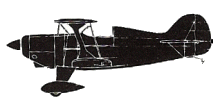
ASN Wikibase Occurrence # 165966
This information is added by users of ASN. Neither ASN nor the Flight Safety Foundation are responsible for the completeness or correctness of this information.
If you feel this information is incomplete or incorrect, you can submit corrected information.
| Date: | Saturday 3 May 2014 |
| Time: | 19:45 |
| Type: |  Pitts Model 12 |
| Owner/operator: | Private |
| Registration: | N177MF |
| MSN: | 299 |
| Year of manufacture: | 2009 |
| Total airframe hrs: | 146 hours |
| Engine model: | Vendenyev M14P |
| Fatalities: | Fatalities: 0 / Occupants: 2 |
| Aircraft damage: | Substantial |
| Category: | Accident |
| Location: | Near Jordan Narrows Park, south of Draper, UT -
 United States of America United States of America
|
| Phase: | Landing |
| Nature: | Private |
| Departure airport: | The Dalles, OR (DLS) |
| Provo, UT (PVU) | |
| Investigating agency: | NTSB |
| Confidence Rating: |
The private pilot had recently purchased the experimental airplane, and the flight was the second leg of his cross-country trip to fly the airplane home from the purchase location. After the first leg, the pilot topped off the main and auxiliary (wing) fuel tanks, which, according to the pilot's operating handbook (POH) for the airplane, provided a total usable fuel quantity of 53 gallons. After flying about 3.5 hours, when the airplane was about 20 miles short of the planned destination, the engine lost total power, and the pilot was unable to restart it. During a forced landing in a field, the airplane nosed over and came to rest inverted. When the airplane was righted during recovery, about 4 to 5 gallons of fluid drained from the area where the main fuel tank and the smoke oil tank were mounted; however, it was not determined whether the fluid was fuel or a mixture of fuel and smoke oil. The auxiliary tank was breached, and no determination of its postimpact fuel quantity could be made.
The engine was a highly modified aftermarket version of one of two different models produced by the original engine manufacturer, a 360-horsepower (hp) model and a 400-hp model, and no specific fuel burn chart for the modified engine had been developed. The pilot's flight planning, which was based on fuel burn rates for a 360-hp engine, indicated that the flight would consume about 45 gallons of fuel. Calculations using the POH fuel burn rates, which were for a 400-hp engine, indicated that the flight would consume between 51 and 58 gallons, depending on the power setting. Because the auxiliary fuel tank was not equipped with any quantity indication system, and the main tank fuel quantity indicator was difficult for the pilot to see, the pilot used an engine information system (EIS) to determine the fuel state of the airplane. The EIS used a pilot-entered initial fuel quantity and a sensed fuel flow rate to calculate the fuel remaining. Although the pilot reported that the EIS indicated that about 11 gallons of fuel was on board at the time of the power loss, the investigation was unable to determine the accuracy of that EIS-calculated quantity.
Based on the available information, the power loss was likely the result of either an ignition or fuel problem. However, due to damage to the airplane that precluded a complete examination of the ignition and fuel systems, a lack of design and construction information, and the inability to accurately determine the airplane's postimpact fuel quantity, the reason for the loss of engine power could not be determined.
Probable Cause: A complete loss of engine power for reasons that could not be determined because of insufficient evidence.
Accident investigation:
 |
|
Sources:
NTSB
FAA register: http://registry.faa.gov/aircraftinquiry/NNum_Results.aspx?NNumbertxt=177MF
Location
Revision history:
| Date/time | Contributor | Updates |
|---|---|---|
| 04-May-2014 04:32 | Geno | Added |
| 07-May-2014 07:56 | Anon. | Updated [Departure airport] |
| 13-May-2014 06:19 | Geno | Updated [Time, Departure airport, Source] |
| 21-Dec-2016 19:28 | ASN Update Bot | Updated [Time, Damage, Category, Investigating agency] |
| 29-Nov-2017 14:22 | ASN Update Bot | Updated [Operator, Other fatalities, Departure airport, Destination airport, Source, Narrative] |
Corrections or additions? ... Edit this accident description
The Aviation Safety Network is an exclusive service provided by:


 ©2024 Flight Safety Foundation
©2024 Flight Safety Foundation